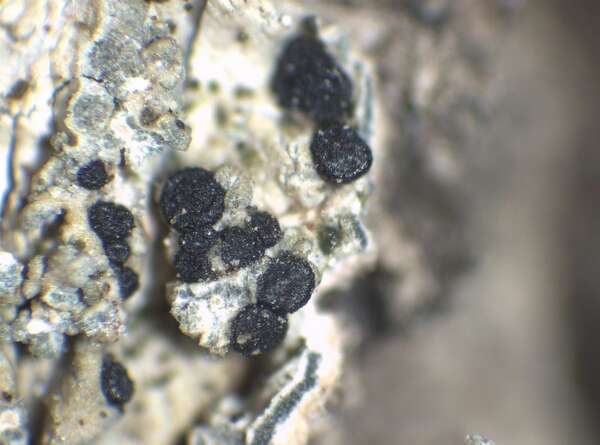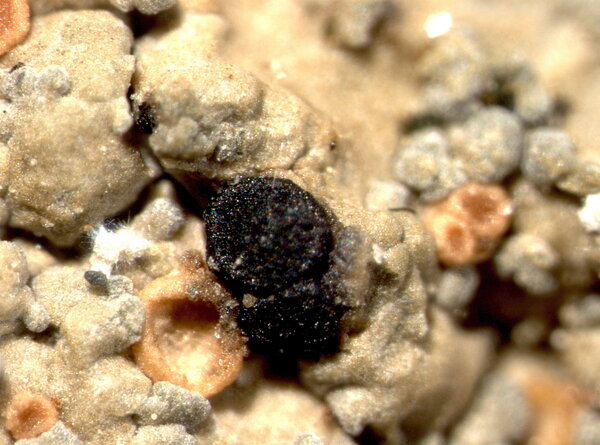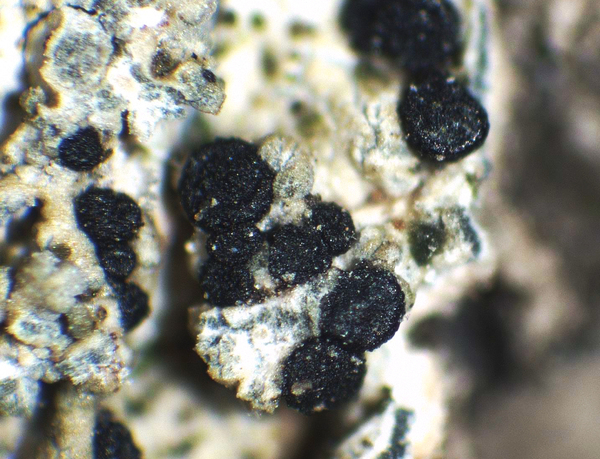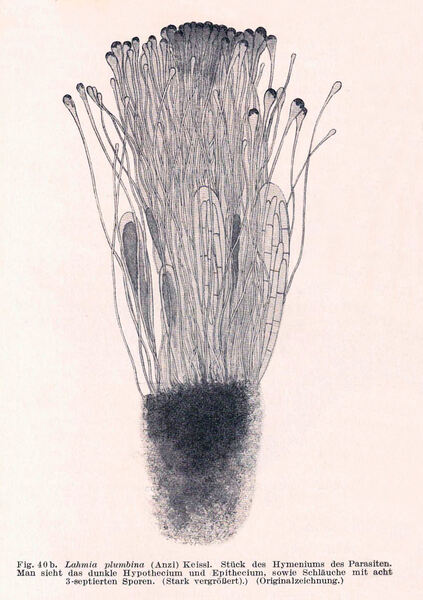Toninia plumbina (Anzi) Hafellner & Timdal
in Timdal, Opera Bot., 110: 85, 1991. Basionym: Leciographa plumbina Anzi - Comm. Soc. Critt. Ital., 1, 3: 158, 1862.
Synonyms: Bacidia plumbina (Anzi) R. Sant.; Bilimbia plumbina (Anzi) H. Olivier
Distribution: N - Emil (UPS-F-523945, Brackel 2016, Fariselli & al. 2020), Lig (Brunialti & al. 2001, Brackel 2016). C - Tosc (Brackel 2016), Umb (Ravera 1998, 1998b, Ravera & al. 2006, Brackel 2016), Laz (Ravera 2001, Brackel 2016), Sar (Brackel 2016). S - Camp (Nimis & Tretiach 2004, Garofalo & al. 2010, Catalano & al. 2016, Brackel 2016, 2021), Bas (Bartoli & Puntillo 1996, 1998, Brackel 2016), Cal (Puntillo 1996, Puntillo & Puntillo 2004, Brackel & Puntillo 2016, Brackel 2016).
Description: Thallus not apparent, not lichenized, developing inside the thalli of Pectenia-species. Apothecia lecideine, black, to 0.6 mm across, with a flat to slightly convex, epruinose disc, and a thin, finally often excluded proper margin. Proper exciple brownish black to greenish black in outer part, dark brown within, K-, the greenish pigment reacting N+ violet; epithecium dark olivaceous green to bright green, K-, N+ violet, lacking crystals; hymenium colourless, 50-60 μm high; paraphyses simple or sparingly branched and anastomosing, not conglutinated, the apical cell distinctly swollen and covered by a gelatinous pigment cap; hypothecium dark brown. Asci 8-spored, clavate, surrounded by a gelatinous I+ blue coat, with a well-developed I+ blue tholus with a I+ darker blue tube and a well-developed ocular chamber, Bacidia-type. Ascospores (1-)3(-5)-septate, hyaline. fusiform to bacilliform. (14-)18-30 x 3-4.5 μm. Photobiont absent. Spot tests: all negative. Chemistry: without lichen substances.Note: a Mediterranean-Atlantic, mainly western lichenicolous fungus growing on species of Pectenia, most frequent in Tyrrhenian Italy. It is included in the Italian red list of epiphytic lichens as “Near-threatened” (Nascimbene & al. 2013c).
Growth form: Lichenicolous fungus
Substrata: bark
Reproductive strategy: mainly sexual
Most common in areas with a humid-warm climate (e.g. most of Tyrrenian Italy)
paras Pectenia spp.
Commonnes-rarity: (info)
Alpine belt: absent
Subalpine belt: absent
Oromediterranean belt: absent
Montane belt: absent
Submediterranean belt: absent
Padanian area: absent
Humid submediterranean belt: extremely rare
Humid mediterranean belt: extremely rare
Dry mediterranean belt: absent

Predictive model
Herbarium samples

Wolfgang von Brackel - Source: Brackel von W. 2021. Lichenicolous fungi from Campania (Italy) Borziana, 2: 31-68.
Italy
Toninia plumbina on Pectenia plumbea, Campania, Cilento 2016.


P.L. Nimis; Owner: Department of Life Sciences, University of Trieste
Herbarium: TSB (31969)
2003/03/17
on the thallus of the host, Degelia atlantica
Growth form: Lichenicolous fungus
Substrata: bark
Reproductive strategy: mainly sexual
Most common in areas with a humid-warm climate (e.g. most of Tyrrenian Italy)
paras Pectenia spp.
Commonnes-rarity: (info)
Alpine belt: absent
Subalpine belt: absent
Oromediterranean belt: absent
Montane belt: absent
Submediterranean belt: absent
Padanian area: absent
Humid submediterranean belt: extremely rare
Humid mediterranean belt: extremely rare
Dry mediterranean belt: absent

Predictive model
| Herbarium samples |

Wolfgang von Brackel - Source: Brackel von W. 2021. Lichenicolous fungi from Campania (Italy) Borziana, 2: 31-68.
Italy
Toninia plumbina on Pectenia plumbea, Campania, Cilento 2016.


 INDEX FUNGORUM
INDEX FUNGORUM
 GBIF
GBIF





